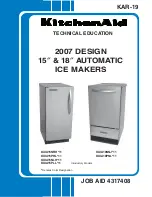
16
Antichlor filter (only in certain models)
The filter eliminates the taste of chlorine in the water. To install
the filter, proceed as follows:
• Release the container from its slot by pulling it upwards
(fig. 1).
• Remove the antichlor filter from the plastic sachet and
rinse it under a running tap (fig. 2).
• Open the container and carefully put the filter in place as
shown in fig. 2.
• Close the container (fig. 2), and reposition it in its slot,
pushing it firmly downwards.
• The antichlor filter should be replaced after 80 cycles, and at
least after every 6 months of operation.
Preparation of filter coffee
• Open the filter-holder door, rotating it towards the right
(fig. 3).
• Fill the jug to the level indicator relative to number of cups
of coffee you wish to prepare, taking care not to exceed
the MAX level (fig.4).
• Pour the water into the water-fill compartment (fig. 5).
• Position the permanent filter (if applicable), or the paper
filter, in the filter-holder (fig. 6).
• Put the ground coffee in the filter using the measuring
cup supplied, and level it off evenly (fig. 7). As a general
rule, use a level measure of coffee (approx 7 grams) for
every cup of coffee required (for example, 10 measures to
obtain 10 cups).
• Close the filter-holder door and place the jug, with cover
in place, onto the hot plate.
• Press the
switch. The light on the switch itself
indicates that the filter coffee-maker is in operation.
• The coffee will begin to come out after a few seconds.
It is perfectly normal for the appliance to emit steam while the
coffee is percolating.
To keep the coffee hot after the percolation process has fini-
shed, place the jug on the hot plate and leave the machine
turned on (with the filter coffee light on): the coffee in the jug
will be kept at the right temperature.
• To turn off the machine press the
switch.
Preparation of espresso coffee
Take note:
Before using for the first time, all the accessories should be wa-
shed and all the internal pipes of the appliance should be well
rinsed. Proceed as if making coffee, repeating until two tanks of
water have been emptied out. The coffee can then be prepared
in the normal way.
Water-softening filter (only in certain models)
Certain models are equipped with a water-softening filter. To
install, proceed as follows:
1. Remove the filter from the packaging.
2. Rotate the calendar disc (see fig. 8) to reveal the next two
months of use.
Take note:
The filter will last the equivalent of two months if the appliance
is used normally. If, on the other hand, the machine is left unu-
sed with the filter installed, it will last for the equivalent of 3
weeks, at maximum.
3. Rinse the filter with at least 0.5 L of running water (fig.
9).
4. Immerge the filter completely in a basin of water, tipping
it to allow any air bubbles to escape (fig. 10).
5. Fill the water-tank, insert the filter in its proper slot (fig.
11) and push it firmly down.
Pre-heating the coffee machine
To obtain an espresso coffee at the right temperature, you are
advised to pre-heat the machine in the following way:
1. Switch on the machine by turning the selector knob into
the position (the relative light will come on) (fig.
12). Attach the filter-holder, complete with filter, to the
machine (fig. 14), without filling it with ground coffee.
Ensure that the pin is correctly inserted in its proper slot,
as indicated in fig 13. Use the smaller filter if you want to
make one cup of coffee, or the larger filter if you wish to
make two.
2. Position a cup under the filter-holder. Use the same cup
in which you intend to make the coffee, so that it will pre-
warm.
3. Wait for the OK light to come on (fig. 15) and then imme-
diately turn the selector knob to position
(fig. 16) Let
the water come out until the OK light goes off, then stop it
by turning the selector knob to position (fig. 12) and
empty the cup.
(It is normal for a small, harmless puff of steam to escape while
the filter-holder is being detached).
Preparation of espresso with ground coffee
1. First, pre-heat the machine and the filter-holder as descri-
bed in the previous paragraph. Use the smaller filter if you
want to make one cup of coffee, or the larger filter if you
wish to make two.
2. If you only want to make one cup of coffee, fill the filter
with a level measure of ground coffee, about 7gr (fig.
Preparation of filter and espresso coffee


























